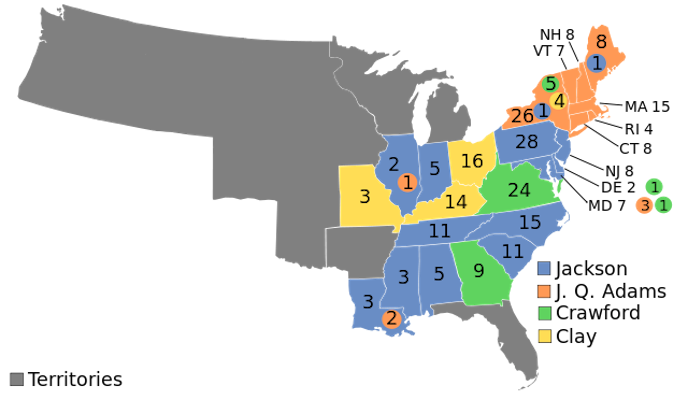A recent eye-catching Washington Post op-ed, reacting to the surges of Trump and Sanders, posed the historically-based question “Are we headed for a four-party moment?” This op-ed had potential — it’s true after all that the seemingly solid two-party system in the U.S. occasionally has fragmented for a few cycles while a major re-alignment occurs — but, for some reason, it only used the 1850s and 1948 as examples (and 1948 isn’t even very illustrative in my view).
A far more intriguing additional parallel would be the 1820s (and the 1830s aftershocks). In 1820, one-party rule under the Democratic-Republican Party was fully achieved on the executive side of government, and no one opposed President Monroe for either re-nomination or re-election. It was the party’s 6th consecutive presidential win. The Federalists remained alive only in Congress, where 32 representatives (just 17% of the House membership) remained. By 1823, there were only 24 Federalists in the House. By the fall of 1824, they had all picked a Democratic-Republican faction to support.
That year’s factionalism, however, was when things fell apart for single-party rule, alarmingly rapidly. The Democratic-Republican Party ran four (4!) different nominees and 3 running mates (Calhoun hopped on two tickets). Andrew Jackson won the popular vote and the most electoral votes, but no one won a majority of the electoral college. So, the U.S. House (voting in state-blocs under the Constitution) had to pick, and they chose Secretary of State John Quincy Adams, the second-place finisher.

1824 presidential election results map. Blue denotes states won by Jackson, Orange denotes those won by Adams, Green denotes those won by Crawford, Light Yellow denotes those won by Clay. Numbers indicate the number of electoral votes allotted to each state. (Map via Wikipedia)
In 1828, when Jackson set out to avenge his 1824 defeat-by-technicality, a huge number of new (but still White and male) voters were permitted to vote for the first time. Contrary to the popular mythology, not every new voter was a Jackson Democrat, though many were. To give a sense of scale for the phenomenon, both Jackson and Adams had gained hundreds of thousands of votes over the 1824 results in their 1828 rematch. At the time, that was so huge that the increases to each in 1828 were actually larger than the entire 1824 turnout had been.
In part as a result of all of this turmoil in the electorate, the party split permanently that year, creating the Democratic Party (which continues to present), under challenger Jackson, and the rival “Adams Men” trying to keep President Adams in office that year. The Democrats under Jackson won easily in 1828. A third party, the Anti-Masons, entered the U.S. House with 5 representatives.
The defeated Adams Men faction, having lost their titular leader, became the Anti-Jacksons — and were officially named National Republicans in 1830. That year, in the midterms, the Anti-Masons picked up more seats, to hold 17, while a 4th party (under Calhoun) of “Nullifiers” sent 4 representatives. But Jackson’s Democrats held a clear House majority.
The large influx of new voters also still needed to be managed, particularly by the opposition. The three big (or sort of big) parties in 1832 — Democrats, National Republicans, and Anti-Masons — held national conventions (all in Baltimore) as part of this democratization and party-organization push. Democrats, however, still clearly held an organizing advantage. Read more





 Monáe has been hyper aware of her image and how others perceive her ever since she came onto the scene over seven years ago. Preferring to be covered up than baring skin or being “revealing” was choice dictated not only by style, but also
Monáe has been hyper aware of her image and how others perceive her ever since she came onto the scene over seven years ago. Preferring to be covered up than baring skin or being “revealing” was choice dictated not only by style, but also 

